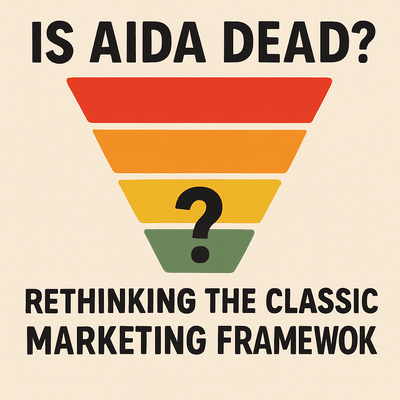In today’s fast-paced, digital-first world, the way businesses communicate with their audiences has fundamentally shifted. Once dominated by vertical, top-down messaging, communication is now multi-directional: customers talk to brands, to each other, and to the wider world through social platforms, reviews, and communities.
This raises a critical question: is AIDA—the 19th-century classic marketing framework—still relevant in the age of social media, personalization, and AI-driven experiences?
What is the AIDA marketing model?
The AIDA marketing model belongs to the family of hierarchy of effects models, which describe consumer decision-making as a step-by-step process. These frameworks assume that people move through sequential stages before making a purchase:
- Attention – Capture the user’s awareness.
- Interest – Sustain engagement with relevance.
- Desire – Build emotional connection and create need.
- Action – Prompt conversion (purchase, sign-up, or trial).
In short, AIDA describes the path from cognition (thinking) to affection (feeling) to conation (doing).
Why AIDA still has values
Despite being more than a century old, AIDA continues to offer value for marketers today. Why? Because while channels, platforms, and algorithms evolve rapidly, human psychology hasn’t changed nearly as much.
- People still need their attention captured in a noisy environment.
- They want relevance and personalization to sustain their interest.
- They make purchase decisions based not only on logic but also on emotional triggers.
- They need clear, easy pathways to take action.
At its core, AIDA provides a psychological baseline—a reminder that marketing is about guiding people from awareness to action, regardless of whether the medium is a TV ad or a TikTok video.
Where AIDA falls short
While AIDA explains persuasion mechanics, it oversimplifies the modern customer journey.
- Linear vs. nonlinear journeys: AIDA assumes a neat, sequential process, but today’s buyers jump between stages, consult multiple touchpoints, and loop back before deciding.
- Push vs. pull dynamics: AIDA was built for a broadcast era, where brands pushed messages. Today, buyers often pull information themselves—researching, comparing, and validating via peers or influencers.
- Post-purchase experience: AIDA ends at “Action,” but modern marketing doesn’t stop at the sale. Retention, loyalty, advocacy, and community-building are now essential.
In other words, AIDA doesn’t fully account for the complexity of omnichannel journeys, subscription models, or the importance of long-term customer relationships.
How AIDA completes marketing funnels
Even with its limits, AIDA remains a useful building block when paired with newer frameworks.
1. Strategic Communication Objectives
- Cognitive (Awareness): Inform consumers about a product and its benefits.
- Affective (Liking/Preference): Build trust, preference, and emotional resonance.
- Conative (Action): Drive trial, purchase, or sign-up.
2. Tactical Applications
- Still highly effective for copywriting—landing pages, ads, and emails often follow the AIDA sequence.
- Provides a storytelling structure: hook attention, build intrigue, connect emotionally, and end with a call to action.
- Works best when integrated into broader, non-linear models like the customer journey map or flywheel framework (Attract → Engage → Delight).
Rethinking AIDA for Today
So, is AIDA dead? Not exactly. It’s more accurate to say that AIDA has evolved:
- From linear to dynamic: Consumers don’t always follow the steps in order.
- From one-way to multi-way: Brands must engage in conversations, not monologues.
- From transactional to relational: The journey doesn’t end at purchase; it continues through loyalty, advocacy, and community.
AIDA is not obsolete, but it’s incomplete. For marketers, it works best when viewed as a foundational lens—a reminder of human behavior—augmented by modern frameworks that reflect the fluid, multi-touch, and relationship-driven reality of today’s marketing.
| AIDA remains valuable as a simple, memorable model for persuasion. But in practice, it needs to be rethought and integrated into modern, customer-centric frameworks that embrace complexity, interactivity, and the full lifecycle of engagement. Share your thoughts in the comments. |
